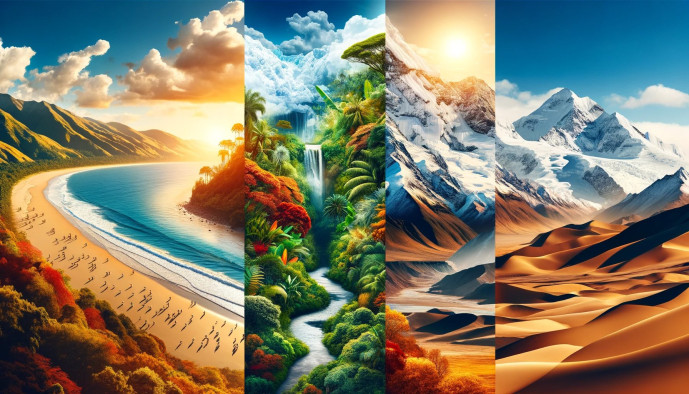Weather and Climate in Peru
Discover Peru's climates: from desert coasts to Andean highlands

Understanding Peru’s Three Climate Zones
Peru’s vast and varied geography creates three distinct climate zones: the arid coast, the high Andes, and the humid Amazon rainforest. This diversity means there is no single “best time” to visit the entire country; the ideal season for one region may be less favorable in another. As a general guide, Peru has two primary seasons: a Wet Season (approximately November to March) and a Dry Season (approximately April to October). However, how these seasons manifest varies dramatically depending on your location.
The Coastal Desert (La Costa)
Climate Overview
This region, which includes Lima, is characterized by a mild, arid to semi-arid climate with very little rainfall throughout the year. The weather is defined by two distinct seasons rather than wet and dry periods.
Summer (December – March)
Weather: Hot, sunny, and often humid.
Average Temperatures: 25-30°C (77-86°F).
What to expect: This is classic beach weather, perfect for enjoying the Pacific coastline. The sun is exceptionally strong, so high-quality, high-SPF sun protection is essential.
Winter (May – October)
Weather: Mild, consistently overcast, and damp.
Average Temperatures: 15-20°C (59-68°F).
Special Phenomenon: The coast, especially Lima, is often covered by the Garúa—a persistent coastal fog or fine drizzle. It rarely turns into heavy rain but creates a grey, damp atmosphere that can feel cooler than the temperature suggests.
The Andean Highlands (La Sierra)
Climate Overview
In destinations like Cusco, Arequipa, and the Sacred Valley, temperature is dictated by elevation, and the year is split into two very clear seasons. The “shoulder months” of April, May, October, and November can offer a pleasant mix of both seasons.
Dry Season (April – October)
Weather: Clear, intensely sunny days followed by cold, crisp nights.
Daytime Temperatures: Can reach a pleasant 20-25°C (68-77°F) in the sun.
Nighttime Temperatures: Often drop significantly to freezing or just below, around 0-5°C (32-41°F).
What to expect: This is widely considered the best time for trekking activities like the Inca Trail due to minimal rainfall. The trade-off is the much colder nights, for which you must be prepared.
Wet Season (November – March)
Weather: Milder temperatures overall, but characterized by frequent, and often heavy, afternoon rain showers.
Daytime Temperatures: A comfortable 18-22°C (64-72°F).
What to expect: The landscape is brilliantly green and there are generally fewer visitors. However, you must be prepared for rain and potential travel disruptions, such as landslides. Please note that the classic Inca Trail is closed for maintenance each year during the month of February.
The Challenge of Altitude and Sun
The sun at high altitudes is extremely strong and can burn skin quickly, even when the air temperature feels cool. Furthermore, the weather in the Andes can change with remarkable speed; a beautiful sunny morning can unexpectedly turn into a cold afternoon hailstorm. This is a key consideration when packing a daypack for any excursion.
The Amazon Rainforest (La Selva)
Climate Overview
The Amazon basin is characterized by a hot, humid, and tropical climate year-round. While high rainfall is a constant, the year is divided into “drier” and “wetter” periods, which primarily affect river levels and wildlife viewing opportunities.
“Drier” Season / Low Water (June – October)
Weather: Hot and humid with less frequent rainfall, though showers are always possible.
Average Temperatures: 30-35°C (86-95°F).
What to expect: As river levels fall, jungle trails that are otherwise submerged become accessible, making this period ideal for land-based hiking and exploration. Be aware that mosquito populations tend to be higher during this time.
“Wetter” Season / High Water (November – May)
Weather: Very hot and humid with frequent, heavy tropical downpours.
Average Temperatures: 28-33°C (82-91°F).
What to expect: The high water levels allow for extensive exploration by boat into otherwise inaccessible, flooded forest areas. This offers a unique perspective on the ecosystem and can bring you closer to canopy wildlife. Mosquito presence is generally lower during this season.
What to Pack: A Climate-Focused Guide
Your packing list should be tailored to the specific regions and seasons of your itinerary. The following is a guide to help you prepare for the distinct climates you will encounter.
For The Coast (Lima, Paracas)
- Summer: Lightweight clothing, swimwear, a wide-brimmed sun hat, sunglasses, high-SPF sunscreen, and sandals.
- Winter: Long-sleeve shirts, a light jacket or fleece, and long pants. The key is layering to combat the damp chill of the Garúa.
For The Andean Highlands (Cusco, Machu Picchu, Arequipa)
Essential Year-Round: Layers are absolutely critical for comfort and safety due to the wide temperature swings between day and night.
- Base Layers: T-shirts, including some moisture-wicking options for hiking.
- Mid Layers: A fleece jacket and one or two warm sweaters are essential for the cold evenings.
- Outer Layer: A waterproof and windproof jacket is non-negotiable for protection against rain and wind.
- Bottoms: Comfortable hiking pants are ideal. Consider thermal leggings to wear underneath in the evenings or on cold trekking days.
- Accessories: A warm hat (beanie/toque), gloves, a scarf, a sun hat for daytime, high-SPF sunscreen, and lip balm with SPF are all necessary.
For The Amazon Rainforest (Iquitos, Puerto Maldonado)
- Clothing: Lightweight, long-sleeved shirts and long pants made of quick-drying fabrics offer the best protection from both the sun and insects. It is advisable to avoid dark-colored clothing, as it can attract more insects.
- Rain Gear: A reliable, breathable rain jacket or a sturdy poncho is absolutely essential.
- Footwear: Waterproof hiking boots are recommended for trails, along with a pair of sandals or flip-flops for relaxing at your lodge.
- Accessories: High-quality insect repellent containing DEET, a sun hat, and sunscreen.